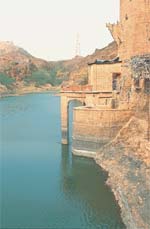Rajasthan's
Water Fort
Chittor fort nestles in the
Aravalli Hills at the eastern border of the Thar desert. It
is perched on the top of a huge oval hill about 152 m high.
It is a water fort.
The fort has 84 water bodies, out of which only about 22
exist today. These Include talabs (ponds), kunds
(wells), and baories (stepwells). All the talabs
have a natural catchment. The kunds and baories
are located below the talabs, so that even the
seepage from the latter is not lost.
The fort spreads over 500 hectares, 40 per cent of which are
given over to water bodies. The average reservoir depth is
about 2 m. Taken together, this means these reservoirs can
store about 4 billion litres of water.
In a year of more than normal rainfall (average annual rainfall:
700 mm), enough water would be stored to last the next 12
months. Even after water loss due to seepage and evaporation
and other causes, an army of 50,000 could live in the fort
for four years without fear of thirst.
Udaipur
Surrounded by hills, Udaipur is located in a saucer-shaped basin
over an area of 475.85 sq km in the Aravalli range, at an elevation
of 573 m. The Ahar river flows through it. The city was founded
by Maharana Udai Singh in 1567. After the third attack on Chittor
Fort, Udai Singh fled from Chittor and took refuge near Udaisagar
lake. In the midst of the Aravalli hills and on the banks of
the Pichhola lake, he built the capital of Mewar. The lake had
earlier been built by a banjara (gypsy) in the late 14th century.
Udaipur is famous all over the world for its enchanting
lakes. The three main lakes are Pichhola, Fatehsagar and Udaisagar.
Pichhola is fed by Sisarma, a non-perennial river. Gorana-ki-nal,
a dam upstream the Aravalli, was connected to the Sisarma
river recently. Fatehsagar has a very small catchment of its
own and is fed by Bari tank, and Chota and Bada Madar. The
overflow from the Bada and Chota Madar tanks merge with the
Ahar river. The Ahar river feeds Udaisagar several kilometres
downstream. The overflow from Bari tank directly merges with
Fatehsagar. The overflow from Pichhola flows into Fatehsagar,
and the overflow from Fatehsagar flows into the Ahar through
a canal before it enters Udaisagar. Below Pichhola and Fatehsagar
are numerous wells and bavdis (stepwells), which were
the only source of drinking water. With this web of lakes
and wells, most of the rain falling within the Udaipur basin
was kept within the basin itself, with very little losses.
Bavdis as saviours
Udaipur faced its worst water crisis in 1987-88 owing to the
widespread drought. Several parts of the city did not get drinking
water for days. People of several localities had to purchase
water. Fatehsagar and Pichhola almost dried up. The authorities
had a brainwave to revive the numerous bavdis, which
were lying in a state of neglect. Parks and buildings had been
built on some of them while others were being used as garbage
dumps. Today, more than 25 bavdis have again been pressed
into water supply service. The bavdis are connected to
the main pipeline which supplies water to Udaipur city. If the
1987 drought had not occurred, nobody would have bothered about
the bavdis, and all of them would have disappeared completely.
In the past few decades, catchment destruction has increased
the rate of siltation, jeopardising the very existence of
the lakes. There was a silt trap between the Madar tank and
Fatehsagar at Thur-ki-pal-village but it has now broken down.
The silt now flows into the Fatehsagar. Urbanisation around
the lakes has turned them into receptacles for organic matter
and domestic wastes.
Jodhpur
 |
The city of Jodhpur is an excellent example of how an extraordinary
water management system has been destroyed in a desert city
through unthinking processes of modernisation and urbanisation.
While selecting the location of the city in 1495 AD, its rulers
must have seriously considered its water potential and strategic
situation. The Chonka-Daijar plateau serves as the water catchment
for 50 functional surface water bodies like nadis,
talabs, tanks and lakes, and indirectly for about 154
groundwater bodies like wells, baoris and jhalaras.
In the past, these surface water bodies were the main source
of water in the city, also providing water through seepage
to wells, baoris and jhalaras in their respective
areas. Many of the water bodies are more than 500 years old.
Jodhpur is perhaps the only city in the country where an all-out
effort was made to conserve every drop of rain water. To achieve
this, every catchment and hillock was drained by canals.
|






